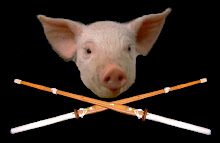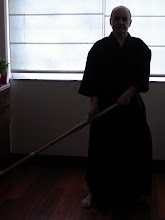Kendo
is a modern Japanese Martial art which literally means “the way of the sword”.
It has been formally introduced in the Philippines with the foundation of the
Manila Kendo Club in the 90s. Though a popular sport which is being practiced
around the world, a lot of misconceptions are still going around about the
nature of this martial art. These misconceptions stem mainly from the portrayal
of the Japanese art of sword fighting by various popular anime series. If you
think Kendo is Samurai X, then you have to consider knowing these facts
first before sporting yourself a shiny:
1.
IT’S REALLY NOISY.
Do
you remember martial arts fight scenes when the fighter shouts in his stance?
Yes, that’s pretty much it. Kendo players scream at the top of their lungs or
make bellowing sounds before or as they charge towards their opponent. This is
called kiai. In Kendo, a loud and fierce kiai is equated to a
player’s strong fighting power. The louder and fiercer, the better. Kiai
is also one of the points being considered in a Kendo tournament. For this
matter, Kendo is considered one of the noisiest martial arts. If you are
looking for a Zen sport, Kendo is definitely not for you.
2.
PREPARE TO GET BLISTERS.
Expect
to get blisters on your soles– lots of it. The fundamental techniques and moves
in this sport basically require good footwork. And the most basic stance
involves a smooth, sliding footwork. You train and fight barefoot. So it is
just natural to develop blisters on your soles as early as your first day of
training. Accuracy and precision in charging stances are even attributed to
excellent footwork. If, by the end of the day you have your soles some thick
blisters, then you may actually be doing things right. That means your footwork
is on the right track! As the sensei usually says (or screams), “Let
them bleed!”
3.
YES, YOU WILL CLEAN.
If
at home you never even bothered to pick up the mop or broom for some domestic
productivity, then it’s about time you learn your manners. The dojo is a
revered place for training. And dojos should always be kept clean, whether
before, during, or after the training.
So
it is customary practice for each Kendo trainee to mop the floor the Japanese
way, that is, body bent and head bowed with a wet rag on both hands while
traversing back and forth the wide dojo floor – until it is squeaky clean. As
with other martial arts, discipline is a core virtue.
4.
IT IS PHYSICALLY INTENSE.
Prepare
to sweat real hard. And get body aches. As with other martial arts, Kendo is
physically demanding and involves strenuous physical activities. And as a
fighting sport, be ready to get hurt. Even when you are already wearing your bogu
(full body armor), there are a number of possibilities and chances for you
to get hit hard with a shinai (bamboo sword) especially when a strike
accidentally lands on an unprotected area of your body. Displeasing your sensei
will also do you no good. Therefore, expect nothing less when practice sparring
without an armor.
5. SENSEIS
ARE AWESOME.
You
will be training under the tutelage of world-renowned, elite senseis
(masters). Although assistant instructors may be in the range of 3rd dan to 4th
dan level, Kendo clubs are usually supervised and led by 6th to 8th dan
Japanese senseis. There are only a few high-ranking Kendo practitioners
in Japan and in the whole world. So senseis higher than 6th dan are
really rare. Training under these highly respected senseis is truly an
honor and a very rare opportunity.
6.
KENDO KNOWS NO AGE.
If
you think that only teens and young adults are into Kendo, then think again. Or
better yet, go to a Kendo dojo and see for yourself. Kendo practitioners have
ages ranging from 6 to 65 years old, male and female. So you need not be
shocked if training with you are the kids next door and your friend’s grandpa.
But as commonly observed, a good percentage of Kendo practitioners belong to
the older age groups, an indication of the sport’s health and physical
benefits.
7.
RANKING EXAMS ARE TOUGH.
Yes,
even in martial arts you will take exams. And they are never easy. Aside from
the rigorous routine physical training, you will need to pass several exams to
be allowed to wear the revered bogu and be authorized to join sparring
sessions and tournaments. From then on, you will also need to pass the
subsequent ranking exams to be promoted to higher kyu and dan
ranks.
8.
YOU FIGHT INTERNATIONAL.
Most
Kendo clubs are members of the International Kendo Federation (IKF) and are
regularly invited to Kendo tournaments outside the country. These tournaments
are usually the highlight of the year for Kendo clubs and their members.
International championships are held all over the world. In Asia, championships
are usually held in Hong Kong and Singapore and are participated by most Asian
countries. In these tournaments, you will witness the best teams fight, and win
the coveted cup.
9.
IT’S AN INVESTMENT.
Not
all martial arts are created equal, especially when it comes to investments.
Unlike other martial arts, Kendo is a fighting sport which requires accessories
and protective armor. And these are a bit pricey. This is primarily because the
accessories, the uniform, and the complete set of protective gear are made from
special raw materials and are usually directly purchased from Japan. So if
you are a Kendoka-wannabe, just a friendly tip – prepare to invest.
10.
YOU ARE NOT SAMURAI X.
Though
majority of younger Kendo club members’ reason for joining is the anime series Samurai
X, it is with utmost apologies to say that being a Kendoka doesn’t make you
Kenshin Himura. You won’t fly and learn the Hitten Mitsurugi technique.
Though Samurai X is a personal favorite and has truly been a
great inspiration to many, there is more to Kendo than the idea of it. Kendo is
a special martial art which teaches one on the right way of the sword, as well
as the core discipline, form, art, and life that comes with it. Kendo is a way
of life.



